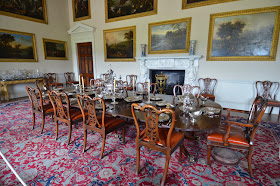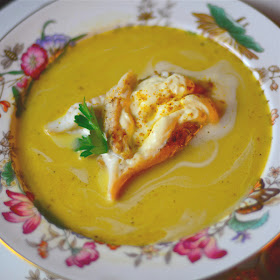Persian Miniature, 1546
Not to be deterred, I looked into the history of tailgating
and that widened my scope to include other sporting events because bringing
food in the back of a car or a wagon to nourish sporting participants and
spectators is as old as the hills.
The Indians did it at polo matches thousands of years ago. Thinking about polo also made me think
of famous English hunt lunches brought out to the fields to fortify the
participants in the grueling event.
These were elegant and delicious affairs (and horses are the only
athletes I enjoy watching!).
New Tiffany Table Settings photo
Fine china, crystal and linen were often packed into truly
drool-worthy leather cases with elegantly tailored fittings to hold the
dinnerware securely for travel.
Great huge baskets were stuffed with provisions and hot and cold food
were placed the appropriate containers with wonderful drinks (champagne? –– oh
yeah). Spirit burners could heat
up what needed heating and it all went off seamlessly with the precision of
military maneuvers performed by a small army of servants with generations of
experience via many tailgates or wagons or carriages.
Conde Nast Photo, Polo Tailgate
Another elegant and usually servant-less tailgating party
possibility is one done for today's polo matches.
The photo with the adorable tent on the vintage station wagon captured
my heart as well.
Although heart-stoppingly exciting to watch, Polo is a
terrifying sport, if you ask me. I
have no end of admiration for anyone who can play it at all, let alone well. The first time a mallet flew by my head
going full speed down a field –– I retired from the fray, shaken and grateful I
was not in the hospital or on my way to the undertaker.
It is a wonder to watch from the comfort of the
sidelines. Called the sport of
kings and king of sports, both horse and rider operate as one and they fly and
twirl like spirits possessed. Tiny
movements cause the horses to change course. I discovered this the hard way riding my neighbor’s new and
supposedly untrained polo pony in my field… almost ended up flying over his
gorgeous black head when I unknowingly made a knee command and he nearly did a
360º turn—he must have thought I was such a clod, I swear he rolled his eyes at
me when I got off!
As you doubtless know, Prince Charles and Prince Harry are
both quite good at it –– they can afford to be. It is not a sport for a light pocketbook –– the rigors of
the game demand many changes of mount during the course of the match,
necessitating the proverbial “string” of polo ponies for each rider that need
to be cared for and moved to matches, often by jet.
I don’t have one of those fabulous picnic hampers and my
car’s trunk is not suitable for display (between the dog hair and tools… it
would put you off your feed to be sure) so you’ll have to use your imagination
for the setting. Just think of the
tented tailgate above!
What to make?
Finding NYT article from 1987 about preparing a polo picnic inspired me. In it, the author recommended elegant
fare and well thought out menus that transport well. Caterer Jennifer Krascella
made hazelnut biscuits with a rhubarb soup for the spread (along with cold veal
stuffed with tuna, summer vegetables in vodka, cheese, fruit, berry-filled
cones with marscarpone and of course –– an 80's menu for sure). The recipe had no milk or baking powder so I added that (I just couldn't figure out how a biscuit without them would work... go to the original if you are braver than I am... I also cut down the sugar since I was using them with a savory filling).
It being fall, I decided to stick with the biscuits and add ham to make a bite-size slider, but then decided I’d share another old favorite of mine
–– deviled ham. When I was a kid I
loved the stuff. When I got older
and looked at the ingredients as well as learning about factory-farmed pork –– I stopped eating it. Then I found this recipe, use organic ham,
and, well, I was in love all over again.
Sorry I can’t tell you where the recipe comes from since I copied it
into my little black recipe book long ago but it’s delicious.
Instead of the classic polo drink, Pimms Cup, I thought I’d
share a wonderful drink I’ve made many times since I found the recipe, a
pomegranate cider from long ago at the 21 Club (I shared this with you before
but it seemed a perfect accompaniment for a tailgate picnic–– it’s so simple
and delicious). Add a little
alcohol and you are good to go on a cool fall afternoon!
Hazelnut Biscuits inspired by Jennifer Krascella
1 1/2 cups hazelnuts,
ground fine
1/2 pound unsalted
butter at room temperature, cubed
2 T to 1/4 cup granulated
sugar (add the sugar to taste)
1 T baking soda
2 cups all-purpose
flour
1/4 teaspoon salt
½ c milk
1 teaspoon vanilla
extract
2 T edible rose
geranium leaves, rinsed and finely chopped (optional)
Place the hazelnuts
in a food processor and process for 20 seconds.
Place the butter and
sugar in the bowl and combine well.
Add the flour,
salt, baking soda and hazelnuts and add, a half cup at a time, to the butter-and-sugar
mixture. Mix until the flour is just incorporated. Add milk.
Add the vanilla and
chopped rose geranium.
Place the dough in a
bowl, cover with plastic wrap and refrigerate for one hour.
Preheat the oven to
350 degrees.
Lightly butter two
cookie sheets or cover with parchment paper.
Remove the dough from
the refrigerator and roll it into 1 1/2-inch balls.
Place the balls a
half-inch apart on the cookie sheets, smush them down a little. I used the extra ground hazelnuts to sprinkle on the top. Bake for 15 minutes, or until golden (mine took 20).
Remove from the oven
and allow to cool on cookie sheets for five minutes.
Transfer the biscuits to a
cake rack and cool for 10 minutes. Store in a tightly covered container.
Yield: 2 dozen biscuits.
Deviled Ham
1/3 c minced onion
¼ c butter
1 T dry mustard
1 T flour
hefty pinch cayenne
1 c scalded cream (you may
want to add more after you chill it if it isn’t creamy enough)
2 c ground ham
2 T Dijon mustard
1T freshly grated
horseradish (or bottled) or to taste ( I added 2 T because I love horseradish)
2 t white wine vinegar if you are using freshly grated horseradish
2 t white wine vinegar if you are using freshly grated horseradish
s & p to taste
Pickle relish, sweet pickle or sour cornichons to serve (optional)
watercress (optional)
watercress (optional)
Saute onion in butter till
soft. Add the mustard and flour
and make a roux. Add the cream and
simmer for 15 minutes. Remove from
heat, add the ham and chill. Add the
horseradish and Salt and pepper to taste
(ham is usually salty… so see what you think). You may want to add more cream after it chills if it is too stiff. Also, it is better the next day.
The biscuits are slightly crisp on the outside. I would recommend putting them together without the pickle so they don't sog up unless you are serving them immediately.
The biscuits are slightly crisp on the outside. I would recommend putting them together without the pickle so they don't sog up unless you are serving them immediately.
Pomegranate
Cider from the 21 Club
4 cups pomegranate
juice
4 cups apple cider
Zest of 1 orange
6 cinnamon sticks
2 star anise
3 cloves
(add a shot of rum, brandy or calvados to taste if you would like –– and I like it with calvados!)
(add a shot of rum, brandy or calvados to taste if you would like –– and I like it with calvados!)
Combine ingredients in
pot. Warm over medium heat to bring to a boil, reduce heat and keep warm for 30
minutes. Strain and serve; garnish cups with a cinnamon stick.
Thanks to Gollum for hosting Foodie Friday!
Thanks to Gollum for hosting Foodie Friday!
PS~ As some of you know, I have been on a sabbatical from my day job in the film business as a production designer. I am doing a little project for a great director that he has written. Not much money, great cast and a big dinner scene. I was wondering if any NYC area bloggers would like to contribute a beautiful dish to the effort for screen credit? Email me if this interests any of you. This would happen somewhere between the 8th and the 19th of November. Details to follow.
PPS ~~ as a result, I will not be able to visit as much as I would like for the next few weeks and may miss a blog or 2... I'll be back before Thanksgiving!!


















































